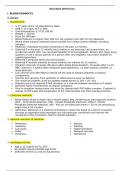Blood Bank ASCP Review
I. BLOOD PRODUCTS
A. Donors
1. Qualification:
≥ 17 years old or as stipulated by state
HGB ≥ 12.5 g/dL HCT ≥ 38%
Oral temperature ≤ 37.5C (99.5F)
Weight > 110 lbs.
Pulse 50-100 bpm
Blood Pressure no higher than 180 mm Hg (systolic) and 100 mm Hg (diastolic)
Whole blood volume collected cannot exceed 10.5 ml/kg of donor weight, including
samples
Rejection: Individual has been transfused in the past 12 months.
Deferred if in the past 12 months had a tattoo or ear piercing, had acupuncture, an
accidental needle stick. has received Hepatitis B immunoglobulin. Donors who share living
quarters or are a sexual partner of a person with viral hepatitis, have been treated for
syphilis/gonorrhea.
Deferred if pregnant within the last 6 weeks.
Deferred if recently traveled to areas endemic for malaria for 12 months.
Donation intervals: 8 weeks (56 days) after whole blood donation, 16 weeks after 2-unit
RBC collection, 4 weeks after infrequent plasmapheresis, >2 after plasma, platelet, or
leuko-pheresis
Low volume unit (300-405mL)-should not be used to prepare platelets or plasma
components
Toxoids and vaccines from synthetic or killed sources have no deferral.
The minimum platelet count for platelet repeat donors is 150 x 10^3/uL
Platelet count not required if first donation or if interval between donations is 4 weeks.
Directed: Same requirements as regular donations.
Prior to donation venipuncture site must be cleaned with PVP iodine complex. If patient is
allergic to PVP clean with preparation of 2% chlorhexidine and 70% isopropyl alcohol.
2. Collection methods:
Whole Blood: blood is drawn into a sterile plastic bag containing an anticoagulant solution
(ACD – Acid Citrate Dextrose, CPD – Citrate Phosphate Dextrose, CPDA-1 -Citrate
Phosphate Dextrose Adenine), 405 - 495 mL are blood are drawn + 30 mL for processing,
target time 4-10 minutes.
Apheresis: Apheresis is a medical technology in which the blood of a person is passed
through an apparatus that separates out one particular constituent and returns the
remainder to the circulation. Used to donate platelets.
3. Adverse reactions of donation:
Weakness Nausea
Sweating Fainting
Low pulse Hyperventilation
Pallor Delayed syncope
Dizziness Hematoma
4. Autologous Donor:
Hgb ≥ 11.0 gm/dl HCT≥ 33%
No weight requirement/No age limits
Deferred if there is a risk for bacteremia
, 3 days in between donations, last one 72 hrs. before surgery
B. Processing
1. Testing:
ABO Type forward/reverse
Rh type (weak D is performed)
Antibody screen
HIV, Antibody to Treponema pallidum (Syphilis), HBsAg, anti-HIV-1 (screening: ELISA,
confirmatory: western blot), anti-HIV-2, anti-HBc, anti-HCV, anti-HTLV I/II, Trypanosoma
cruzi (Chagas Disease), CMV, dHBV, dHCV, dHIV, HIV-1/HCV/HBV (NAT), West Nile Virus
NAT, Babesia NAT RNA.
2. Labeling
Number
Name of component
Name of anticoagulant
Volume of unit
Facility collecting unit (name, address, ID number)
Temperature at which unit should be stored
Expiration date (month, date, year)
C. Storage
1. Anticoagulants/additives:
ACD-Acid Citrate Dextrose (21-day expiration)
CPD-Citrate Phosphate Dextrose (35-day expiration)
, CPDA-1 -Citrate Phosphate Dextrose Adenine (35-day expiration)
2. Temperature requirements/ Transportation/Expiration:
Effects of storage on Red Cell Components: decrease in 2,3 DPG levels, decrease in ATP,
and increase in K+
Whole Blood Storage/Expiration:
o 1-6 C Storage/Transport: 1-10 C
o Expiration: ACD/CP2D: 21 days and CPD/CPDA-1: 35 days.
o Irradiated: 28 days from irradiation (before original expiration).
o Split open system: 24 hrs./Split closed system: original expiration.
o Washed open system: 24 hrs.
o Frozen: 10 yrs. at <-65 C (once thawed 24 hrs.).
Platelets Storage/Expiration:
o Storage: 20-24 C with gentle agitation/Transport: 20-24 C
o Expiration: 5 days in polyolefin type container, platelet in syringe has 4 hrs.
expiration, platelet aliquot in platelet bag (closed system) has original expiration.
Pooled platelets have a 24 hrs. expiration.
*pH must be maintained ≥ 6.2 throughout storage*
Granulocytes Storage/Expiration: 20-24 C, Transport: 20-24 C, Expiration: 24 hrs.
Cryoprecipitate Storage/Expiration: <-18 C, Transport: maintain frozen, Expiration: 1 year,
after thawing maintained at room temp and expiration is 6 hrs., thawed pooled
cryoprecipitate has a 4 hrs. expiration.
Fresh Frozen Plasma (FFP) Storage/Expiration: <--18 C, 12 months or <-65 C, 7 years,
Transport: maintain frozen, thawed 1-6C, split in open system has 24 hrs. expiration,
syringe (closed system) has 24 hrs. expiration.
D. Blood Components
1. Red blood cells: Prepared from whole blood. Indications for use: Acute blood loss, trauma,
chronic severe anemia, leukemia, thalassemia, and exchange transfusion.
2. Cryoprecipitate Antihemophilic Factor (AHF): is prepared by thawing whole blood derived FFP
stored at 1-6C and recovering the precipitate. The precipitate is then refrozen within 1 hour at <
-18C and is suitable for use within one year after the collection date. CRYO contains Factor VIII,
von Willebrand’s factor, Factor XIII, fibrinogen, and fibronectin. Each unit of CRYO should contain
at least 80 IU of Factor VIII and at least 150 mg of fibrinogen in 5 to 20 mL of plasma. Indications
for use: Treatment of acquired or inherited fibrinogen deficiency and Factor XIII deficiency,
treatment of von Willebrand’s disease and Hemophilia A when concentrates are not available.
May be used for preparation of “fibrin glue”. CRYO is mixed with thrombin for this preparation
and used topically to prevent bleeding from the surgical site for some surgical procedures.
3. Platelets: Prepared from whole blood or collected through apheresis. Prepared from whole
blood with light spin to separate plasma followed by hard spin to concentrate platelets.
Indications for use: bleeding, low platelet count, platelets not working properly. Not given for TTP
or ITP unless absolutely necessary. Single platelet apheresis product ≥ 3.0 X 10^11. Random
donor platelet product ≥ 5.5 x 10 ^10. A leukocyte reduced platelet apheresis product must
contain ≤ 5.0 X 10^6 WBCs.




